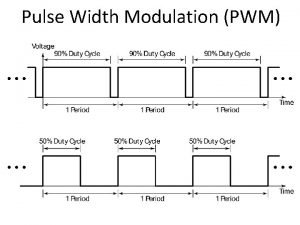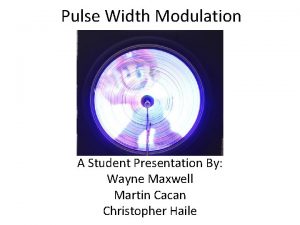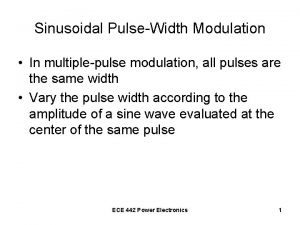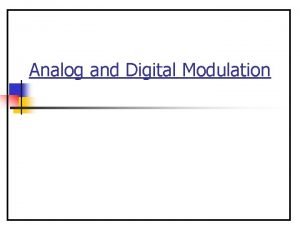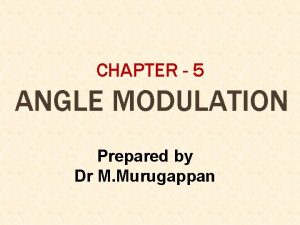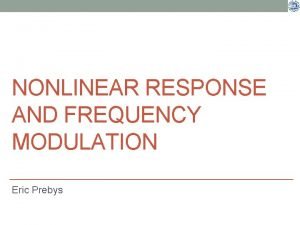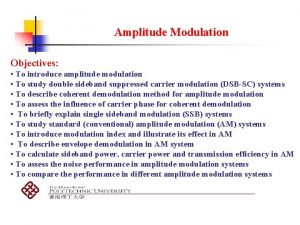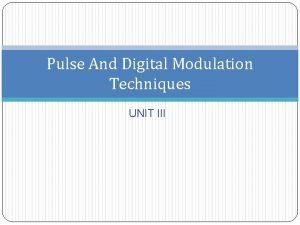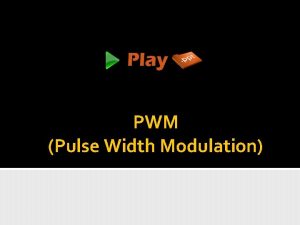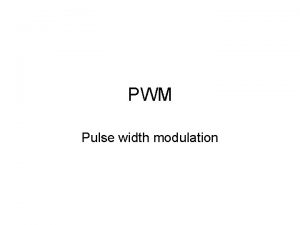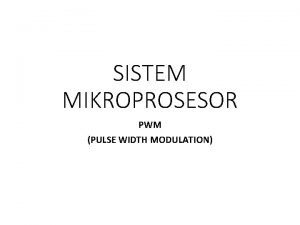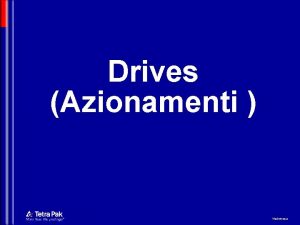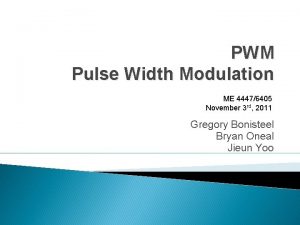Pulse Width Modulation PWM Pulse Width Modulation PWM











- Slides: 11

Pulse Width Modulation (PWM)

Pulse Width Modulation (PWM) 100%

Pulse Width Modulation (PWM) 0% • On the chip. KIT there are 490 periods per second. • Use analog. Write(pin, value) to control the duty cycle on a pin. • The value must be between 0 and 255. • The pin must be one of the underlined pins.

Pulse Width Modulation (PWM) • If you take the average value over one period, you can think of the voltage as being between 0 V (0% duty cycle) and 3. 3 V (100% duty cycle). • There are 256 different voltage levels (0 to 255).

Conversion of Analog to Digital • Obtain “analog” input using analog. Read(). • analog. Read() returns a value between 0 (if pin at ground) and 1023 (if pin at 3. 3 V). • Argument of analog. Read() is the pin to read (only pins labeled ANALOG IN can be used). • Used this to read setting of a potentiometer.

Pulse Width Modulation (PWM) Wrote led_with_potentiometer for this circuit.

Dimmable LED Program int pot. Pin = 0; // Pin for potentiometer. int led. Pin = 9; // Pin for LED. int pwm. Value = 0; void setup() { Serial. begin(9600); // To see potentiometer setting. } void loop() { // Read potentiometer value and set PWM value. pwm. Value = analog. Read(pot. Pin) / 4; Serial. println(pwm. Value, DEC); analog. Write(led. Pin, pwm. Value); // Set PWM duty cycle. delay(15); // Waits 15 ms. }

Different Circuit; Same Result

Transistor: Electrically Controlled Switch If “base” of the transistor is high, then current can flow freely.

Transistor: Electrically Controlled Switch If “base” of the transistor is low, then current cannot flow.

Variable Speed Motor
 Pulse width
Pulse width Advantages of pwm
Advantages of pwm What is duty cycle
What is duty cycle Multiple pulse width modulation
Multiple pulse width modulation Average value of signal
Average value of signal Wave modulation
Wave modulation Advantages of angle modulation
Advantages of angle modulation Amplitude modulation vs frequency modulation
Amplitude modulation vs frequency modulation Amplitude modulation conclusion
Amplitude modulation conclusion Pulse code modulation and demodulation
Pulse code modulation and demodulation Pcm pulse code modulation
Pcm pulse code modulation Advantages and disadvantages of dpcm
Advantages and disadvantages of dpcm
